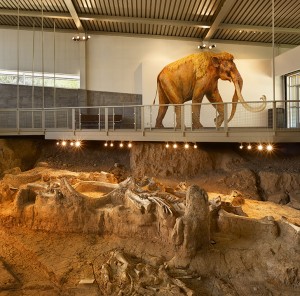
Lariat File Photo
Staff Writer
The recent government shutdown may extend the deadline of a petition on the White House’s website requesting national park status for the Waco Mammoth Site.
Jeff Goodman, program administrator for the city of Waco Parks and Recreation, said he doesn’t know if the deadline has been extended, because deadline extensions for petitions are only applicable to petitions issued after Oct. 1, according to the White House website.
The petition was posted earlier than that and given until Oct. 11 to gain signatures.
The recent petition came not from a Wacoan, but from an unnamed individual in Florida who visited the mammoth site. This individual was interested in paleontology and thought the Mammoth Site was important, Goodman said.
After hearing of the petition, on Sept. 18 the city of Waco Parks and Recreation posted a link to it on their Facebook page and on the mammoth site’s Facebook page, Goodman said. He said the petition needs 100,000 signatures to gain executive attention.
“The last time I saw the site, we had 600 plus signatures,” Goodman said, referencing numbers he said he saw about two weeks ago.
Goodman said he cannot remember the exact parameters of the petition, and the petition is not available to read.
“If I remember correctly, what it is, is they’re petitioning for the president to sign the site by executive order, rather than going back through the process of going through Congress and the Senate approval,” he said.
The city of Waco, Baylor and the National Park Service have been working together for a while at the site, Goodman said.
The National Park Service performed a survey in 2003 on site to see if the Waco Mammoth Site is worthy of national park status, and they determined that it is, he said, because the quantity of juvenile skeletons in the matriarchal herd made it significant.
“The study that the National Parks Service put together showed that it was a significant American treasure that needed to be designated as a national monument,” Goodman said.
Valley Mills junior Vanessa Baum has volunteered with the Waco Mammoth Site and visited numerous times. Baum said she believes the site needs to be a national landmark.
“The reason they can’t get the 100,000 votes they need is because nobody in Waco knows it exists,” Baum said.
Baum said she thinks the Waco Mammoth Site is important, because though people can go about their daily lives not needing to know about the mammoth site, learning more about the history of the area in which they reside will better them as people.
“I think that if you want to understand your community, if you want to understand your environment more, then it is important that you understand the mammoth site, and understand that animals like Colombian mammoths and prehistoric camels and sabertooth cats all lived right here where we live,” she said.
Two attempts, one carried by former U.S. representative Chet Edwards, the other by current U.S. representative Bill Flores, were made in Congress, to pass a bill giving the mammoth site national park status.
Waco city officials and Baylor had backed the bill from the beginning, Goodman said. Both representatives got the bill passed in the House of Representatives, Goodman said, but it never made it through the U.S. Senate.
A bill must be approved by both House and Senate, and by the president, to become law. The bill for the mammoth site never even got to Senate floor to be voted on, Goodman said.
The bill was originally given a hold from an Oklahoma senator because of how federal funding was being allocated at the time, Goodman said. Every bill going through the Senate was getting put on hold and reviewed carefully as Senators looked for hidden expenditures, he said.
There was then a debate about funding, Goodman said. The question was posed: If the national government can’t afford to take care of parks the nation has have now, why add more parks?
“One thing the city of Waco committed to was we wanted the designation,” Goodman said. “The designation was important for the mammoth site. And it was something that this community worked very hard to achieve, and it was kind of the last piece of the puzzle. We’ve raised the money, the facility is open, the public gets to see the remains and hear the story. The last thing we’ve got on our plate is this national park designation.”
The city of Waco made a proposition to the National Park Service, saying the city is financially committed to the mammoth site, Goodman said. If the government gave the site designation, Waco would continue to fund and operate it until the National Park Service could give the site funding, Goodman said.
The proposition was received well, Goodman said, but the National Park Service didn’t know how it could run the facility. It wouldn’t be able to conduct business, he said.
Baum said she doesn’t care about where the money comes from, whether federal, state or local funds.
“As far as whether education be a good use of federal money 100 percent yes,” Baum said.
Having a national park in the community would be good for Waco, Goodman said. With this landmark, the proximity to Interstate 35 would be one of the closest the U.S. has of a landmark to a major roadway, Goodman said.
The anticipated number of visitors is projected to be large if the site ever gains national park status, he said.
“If people are traveling around the country, people are looking for national parks and national monuments, places to go and places to visit,” Goodman said.



